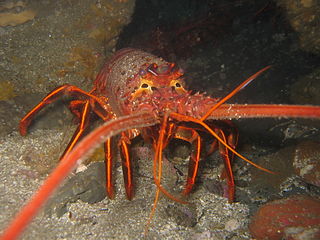
The California spiny lobster is a species of spiny lobster found in the eastern Pacific Ocean from Monterey Bay, California, to the Gulf of Tehuantepec, Mexico. It typically grows to a length of 30 cm (12 in) and is a reddish-brown color with stripes along the legs, and has a pair of enlarged antennae but no claws. The interrupted grooves across the tail are characteristic for the species.

Lobsters are widely fished around the world for their meat. They are often hard to catch in large numbers, but their large size can make them a profitable catch. Although the majority of the targeted species are tropical, the majority of the global catch is in temperate waters.

Panulirus cygnus is a species of spiny lobster, found off the west coast of Australia. Panulirus cygnus is the basis of Australia's most valuable fishery, making up 20% of value of Australia's total fishing industry, and is identified as the western rock lobster.
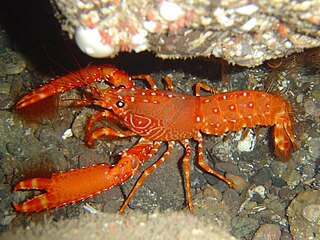
Reef lobsters, Enoplometopus, are a genus of small lobsters that live on reefs in the Indo-Pacific, Caribbean and warmer parts of the Atlantic Ocean.
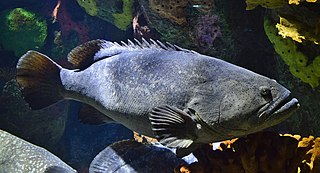
The giant grouper, also known as the Queensland grouper, brindle grouper or mottled-brown sea bass, is a species of marine ray-finned fish, a grouper from the subfamily Epinephelinae which is part of the family Serranidae, which also includes the anthias and sea basses. It has a wide Indo-Pacific distribution and is one of the largest extant species of bony fish.
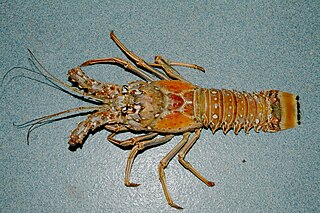
Panulirus argus, the Caribbean spiny lobster, is a species of spiny lobster that lives on reefs and in mangrove swamps in the western Atlantic Ocean.

Panulirus versicolor is a species of spiny lobster that lives in tropical reefs in the Indo-Pacific. Other names include painted rock lobster, common rock lobster, bamboo lobster, blue lobster, and blue spiny lobster. P. versicolor is one of the three most common varieties of spiny lobster in Sri Lanka, alongside Panulirus homarus and Panulirus ornatus.

Pseudosquilla ciliata, the common mantis shrimp, is a species of mantis shrimp, known by common names including rainbow mantis shrimp and false mantis shrimp. It is widespread in the tropical Indo-Pacific region and in both the western and eastern Atlantic Ocean.

Scyllarides latus, the Mediterranean slipper lobster, is a species of slipper lobster found in the Mediterranean Sea and in the eastern Atlantic Ocean. It is edible and highly regarded as food, but is now rare over much of its range due to overfishing. Adults may grow to 1 foot (30 cm) long, are camouflaged, and have no claws. They are nocturnal, emerging from caves and other shelters during the night to feed on molluscs. As well as being eaten by humans, S. latus is also preyed upon by a variety of bony fish. Its closest relative is S. herklotsii, which occurs off the Atlantic coast of West Africa; other species of Scyllarides occur in the western Atlantic Ocean and the Indo-Pacific. The larvae and young animals are largely unknown.

Panulirus pascuensis is a species of spiny lobster found around Easter Island and the Pitcairn Islands in the Pacific Ocean. It is known in English as the Easter Island spiny lobster and in Spanish as Langosta de Isla de Pascua. This lobster is fished on a small scale for local consumption.

Panulirus homarus is a species of spiny lobster that lives along the coasts of the Indian and Pacific Oceans. It lives in shallow water, and feeds on the brown mussel Perna perna. It typically grows to a length of 20–25 cm (7.9–9.8 in). Alongside the dark green nominate subspecies, two red subspecies are recognised, one around the Arabian Peninsula, and one around southern Africa. It is the subject of small-scale fishery.

Panulirus brunneiflagellum is a species of spiny lobster that lives around the Ogasawara Group of southern Japan. Its members were previously included in P. japonicus, although it may be more closely related to P. femoristriga. It has been fished for more than 150 years by Japanese fishermen, who call the species aka-ebi. It differs from related species by the lack of banding along the flagella of the first pair of antennae.

Panulirus ornatus is a large edible spiny lobster with 11 larval stages that has been successfully bred in captivity.
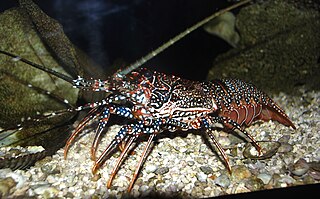
Panulirus guttatus, the spotted spiny lobster or Guinea chick lobster, is a species of spiny lobster that lives on shallow rocky reefs in the tropical West Atlantic and Caribbean Sea.
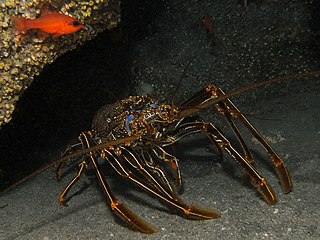
Panulirus echinatus, the brown spiny lobster, is a species of spiny lobster that lives on rocky reefs in the tropical western Atlantic Ocean and central Atlantic Islands.

Panulirus longipes, the longlegged spiny lobster, is a species of spiny lobster that lives on shallow rocky and coral reefs in the tropical Indo-Pacific region. The International Union for Conservation of Nature has assessed its conservation status as being of "least concern".

Panulirus penicillatus is a species of spiny lobster that lives on shallow rocky and coral reefs in the tropical Indo-Pacific region. Common names for this spiny lobster include variegated crayfish, tufted spiny lobster, spiny lobster, Socorro spiny lobster, red lobster, pronghorn spiny lobster, golden rock lobster, double spined rock lobster and coral cray. It has a very wide range and the International Union for Conservation of Nature has assessed its conservation status as being of "least concern".
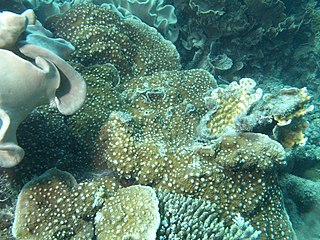
Oxypora lacera, the ragged chalice coral or porous lettuce coral, is a species of large polyp stony corals in the family Lobophylliidae. It is a colonial coral which can be submassive, encrusting or laminar. It is native to the western Indo-Pacific.

Panulirus inflatus, the blue spiny lobster, is a species of crustacean in the family Palinuridae. It is found at rocky reefs to depths of 30 m (100 ft) in the Pacific Ocean off Mexico, ranging from Baja California to Chiapas. It is commonly caught in artisanal fisheries, but the species is not threatened, being categorized as least concern by the IUCN. There are no subspecies.

Cinetorhynchus rigens is a species of shrimp in the family Rhynchocinetidae. Common names include mechanical shrimp, Atlantic dancing shrimp, red night shrimp and red coral shrimp. It occurs in shallow water in the tropical Atlantic Ocean.





















